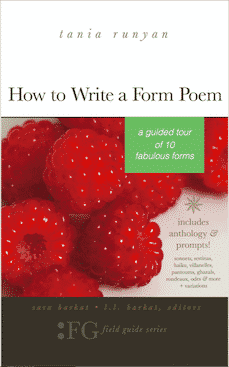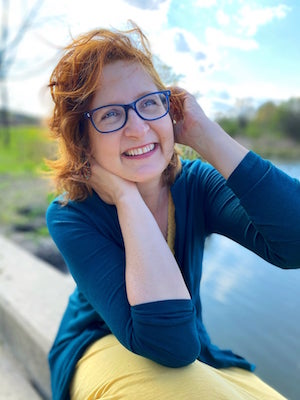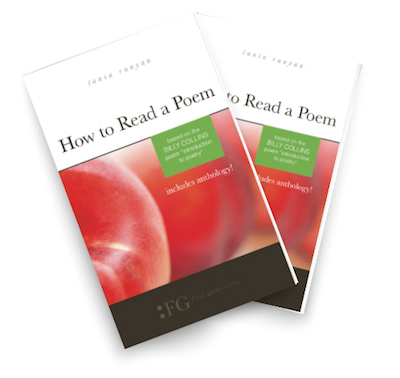An inspiring poetry handbook
Are you looking for a poetry handbook—one that will spark your imagination and guide you in the pleasures of writing poetry with heart and soul?
Explore this inspiring “workshop in a book.”
No matter your level, you can make poems that express more deeply and impact more richly. Poems to keep. Poems to share.
It Builds on How to Write a Poem
From the author of How to Read a Poem and How to Write a Poem, comes a truly delightful book on how to write poetry in form.
Tania Runyan’s previous How to Write a Poem focused on free verse. It covered the powerful techniques of poetry writing: image, sound, line breaks, surprising insights, risk-taking, revision strategies.
It also provided practical resources to get your poems published.
This companion book builds on How to Write a Poem, revealing the world of classic and new poetry forms, to help you grow and explore more.
Imaginative and Fun Guide With Tips
How to Write a Form Poem is a helpful guide for poetry beginners.
It’s an inspiring reference (and a fun read) for experienced poets of all levels.
It’s also a useful tool for teachers who want an accessible, informative, imaginative text for students—with plenty of tips for how to actually approach writing the forms, lots of sample poems to illustrate the forms + intriguing poetry prompts!
Sonnets, Sestinas, Haiku, and So Much More
How to Write a Form Poem covers 10 fabulous forms—sonnets, sestinas, haiku, villanelles, pantoums, ghazals, rondeaux, odes, acrostics (the real kind), found poems + surprising variations on classic forms (triolet, anyone?), to challenge you when you’re ready to go the extra mile.
On the Road With a Fun Poet
You’ll also be entertained by Runyan’s own travel stories that she uses to explain and explore the various forms—the effect of which is to bring form poetry down to earth (and onto your own poetry writing map).
Carnival, lighthouse, monument, state park … she uses them all to help explain the exciting world of how to write poems in form.
Her travels also result in a collection of satisfying sample poems she shares with readers.
Lots of Sample Poems Right in the Book
Besides the sample poems from Runyan, other sample poems include works from both popular and emerging poets from many walks of life and geographies.
In your anthology travels with this book, you’ll meet (or get reacquainted with):
Conor O’Callaghan, Richard Pierce, Ashley M. Jones, Shakespeare, John Keats, Claude McKay, Tom Hunley, Elizabeth Bishop, Celia Lisset Alvarez, Elise Paschen, Frank O’Hara, Victoria Chang, Joshua Gage, Katie Manning, Seth Haines, Natasha Trethewey, David K. Wheeler, Chip Livingston, John McCrae, Rick Maxson, Robert Bridges, Albert Giraud, Charles Henry Luders, Janet Aalfs, Marci Rae Johnson, Angela Alaimo O’Donnell, Matsuo Basho, Matsuo Allard, Amy Lowell, Charles B. Dickson, Christopher Patchel, Michelle Ortega, Ezra Pound, Sandra Heska King, Todd C. Truffin, Erin Keane, John Poch, L.L. Barkat, Susan Rothbard, Gabriel Spera, David Wright, Isaac Willis, Jeanne Murray Walker, Benjamin Myers, Murray Silverstein, Monica Sharman, Barbara Crooker, deb y felio, Faisal Mohyuddin, Edgar Allan Poe, Aaron Brown, Zeina Hashem Beck, Dheepa Maturi, John Drury, Marjorie Maddox, Jill Baumgaertner, Maureen E. Doallas, Juditha Dowd, Thomas Gray, Ron Wallace, Lucille Clifton, Alexander Pope, Clint Smith, Paul Laurence Dunbar, Barbara Howes, Sara Barkat, Megan Willome, Allison Joseph, Claire Batemen, Glynn Young, John Stevenson, Jim Kacian, Carolyn Hall, Roberta Beary, Lorin Ford, Clement Hoyt, and Wallace Stevens. Whew!
Welcome to an Adventure With Extras
How to Write a Form Poem is a little adventure waiting for you.
Along the way, you can explore and enjoy these wonderful extras…
Extras: Interviews & Video Readings Here at Tweetspeak!
1. Poet-a-Day • interviews of 20+ poets featured in How to Write a Form Poem!
2. Video Readings from 26 of the poets featured in the book
Access on Youtube for time stamps to help find a particular poet or visit the Poet-a-Day posts
(Monica joined in after the main event. She’s wonderful!)
Meet the Rest of the “How To” Trio
How to Read a Poem: Based on the Billy Collins Poem “Introduction to Poetry”
How to read a poem. A lot of books want to teach you just that. How is this one different?
Think of it less as an instructional book and more as an invitation. For the reader new to poetry, this guide will open your senses to the combined craft and magic known as “poems”. For the well versed, if you will, this book might make you fall in love again.
How to Read a Poem uses images like the mouse, the hive, the switch (from the Billy Collins poem “Introduction to Poetry”)—to guide readers into new ways of understanding poems. Excellent teaching tool. Anthology included.
How to Read a Poem: What Readers are Saying
I require all my incoming poetry students, in the MFA I direct, to buy and read this book.
—Jeanetta Calhoun Mish
While this book says it’s an invitation, it’s really much more. It’s a conversation—between you (lucky reader), Tania Runyan (funny, helpful friend) and these poems (brilliantly brought to the table by Runyan). No reader, experienced or new to reading poems, will want to miss this winsome and surprising way into the rich, wonderful conversations that poetry makes possible.
—David Wright, Assistant Professor of English at Monmouth College, IL
Runyan expertly brings you into her world of approaching and interpreting poetry, which is both mysterious and ordered. I would recommend this book to anyone hoping to gain insight into poetry. Prepare to have your heart captured!
—Thomas Purnell, Licensed Professional Counselor
Having taught poetry in high schools for over twenty-five years, I’ve grown tired of Intro-to-Poetry texts that feel they must overwhelm the student with the authors’ erudition or the art’s storied history of technique. If there is truly a need for the news only poetry can deliver, then those tomes make dismal advertisements. Tania Runyan has broken with this flat tradition and, in affectionate conversation with the wit of Billy Collins, produced a model for engaging in discovery of poetry’s value—no prior book-learning or companion text required. Which is not to say her ambition is slight; she would thrill to see novices become lifelong readers, even passionate scholars of the art and poets themselves, but she gets it. Her book reads like a playful love letter—a creative intercession on poetry’s behalf—to the hearts of a new generation, those on whom so much, like the future of the art, depends.
—Brad Davis, Poet, teacher, and counselor at Pomfret School
I teach Introduction to Literature, among other courses, and this will be main textbook for the poetry unit from now on.
—Tom Hunley
How to Write a Poem: Based on the Billy Collins Poem “Introduction to Poetry”
Is it possible to teach someone how to write a poem? Or does poetry simply “come from the heart” or from a special talent only some can ever hope to have? Of course there’s no formula for writing an amazing poem. If poems came with instructions like IKEA® coffee tables, we’d all be missing the point.
But this book will give you some strategies—some tools, if you will—to assemble your personal, imaginative raw materials into poems that will surprise and intrigue. These strategies are focused primarily on free verse, yet many of the concepts can also be applied to form poetry, at both the inception and revision stages.
How to Write a Poem uses images like the buzz, the switch, the wave—from the Billy Collins poem “Introduction to Poetry”—to guide writers into new ways of writing poems. Excellent teaching tool. Anthology and prompts included.
How to Write a Poem: What Readers Are Saying
For years I’ve searched for a poetry-writing text that provides enough substance without the inevitable overload of content I’ll never cover. Now my search is complete. The companion to her insightful and accessible How to Read a Poem (and written in the same inviting tone), Tania Runyan’s How to Write a Poem contains three essential elements I’ve yet to find in one poetry-writing text: generous and informed instruction, dozens of compelling example poems, and rich and plentiful exercises that avoid tricks and gimmicks. Any poetry-writing teacher would do well to assign this text. Any writer would do well to draft and revise poems based upon these prompts.
—Nathaniel L. Hansen; Assistant Professor of English & Creative Writing, University of Mary Hardin-Baylor; Director, Windhover Writers’ Festival
How To Write A Poem is a classroom must-have. Through a selection of evocative poetry and a series of accessible exercises, Runyan shows readers how to gather ideas, choose words, strengthen imagery and sound, and she models each of these skills as she writes alongside her readers. This is compassionate, beautiful writing that invites us into the world of poems.
—Callie Feyen, Middle School Teacher, Maryland
I used this book to help teach my high school students how to write a poem. The author has an easy-to-follow process for the reader to use to compose and revise a poem. The anthology of poems included in the book is diverse. I love that the author includes prompts with each poem to get the student to interact with the poem.
—M. Habrych, Amazon reviewer
This book works very well for a college poetry class. Runyan’s work (this book and How to Read a Poem) is accessible, non-threatening, and makes poetry seem fun and relevant. Students enjoy it and are able to apply her ideas to their own writing.
—Laura P., Amazon reviewer
I teach high school creative writing and Runyan’s book is a godsend. I taught an advanced poetry class this past spring, but I had a a group of students with a wide range of poetic knowledge and ability. So I decided to use this book as our foundational text for the whole semester. I was able to use each core idea (image, buzz, line, etc.) as criteria for a rubric that I could use for each poem written over the course of the semester…
…How To Write a Poem is an incredible classroom resource for all young writers—from the novice to the experienced. It is WAY more affordable than most textbooks, and Runyan writes in a way that is encouraging, accessible, and challenging. If you teach writing in any capacity, buy this book. If you yourself have to teach writing but lack confidence in poetry, buy this book for both yourself and your students.
—J. Jacobson, Amazon reviewer
I use this in my Intro to Creative writing class. The chapters are short, include poems at the end (no need to buy expensive anthologies) and easy for the students to work through and then apply what they’ve learned to their own work. I use it in conjunction with How to Read a Poem: Based on the Billy Collins Poem “Introduction to Poetry.”
—Cheryl Russell, Amazon reviewer



